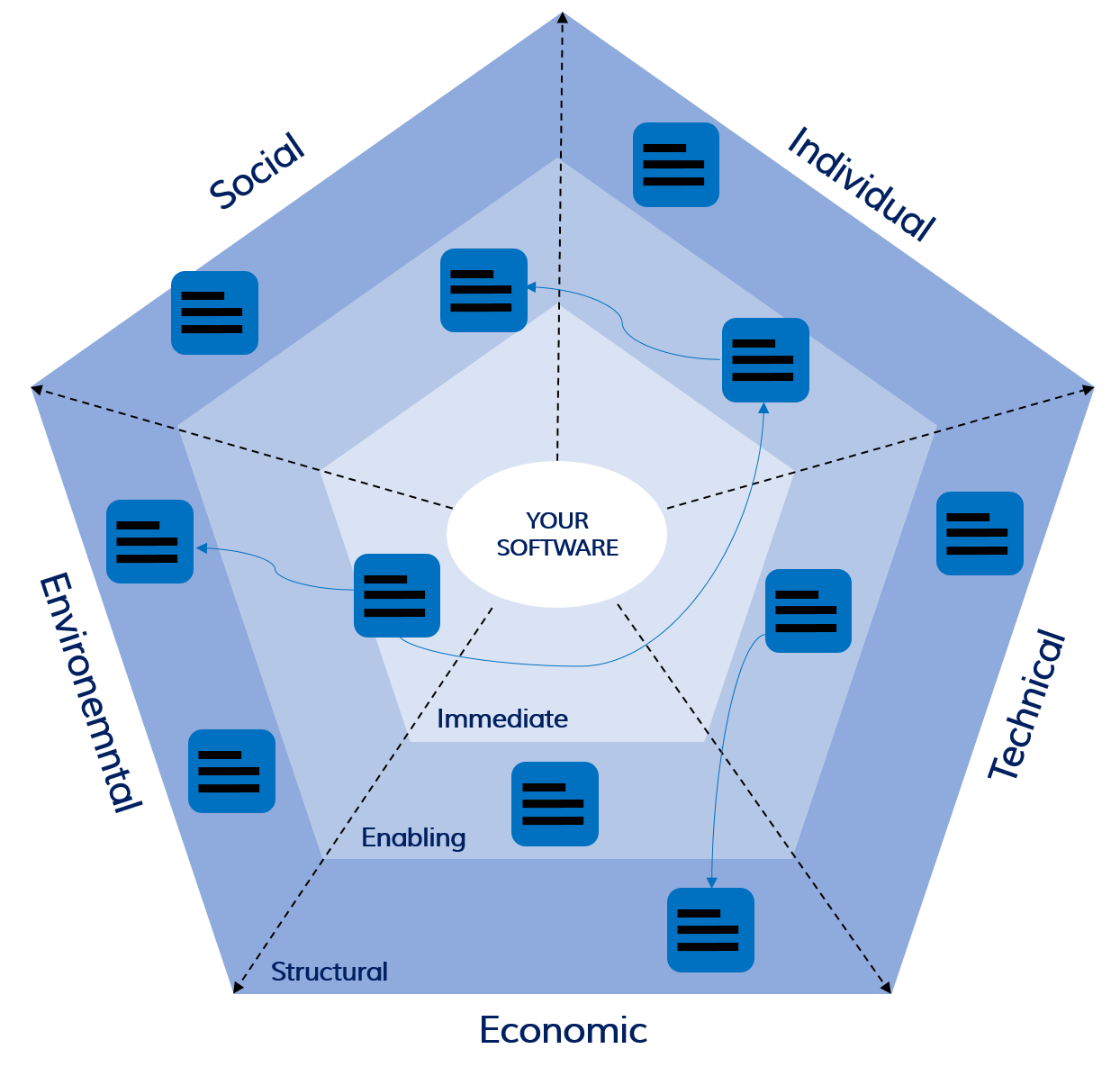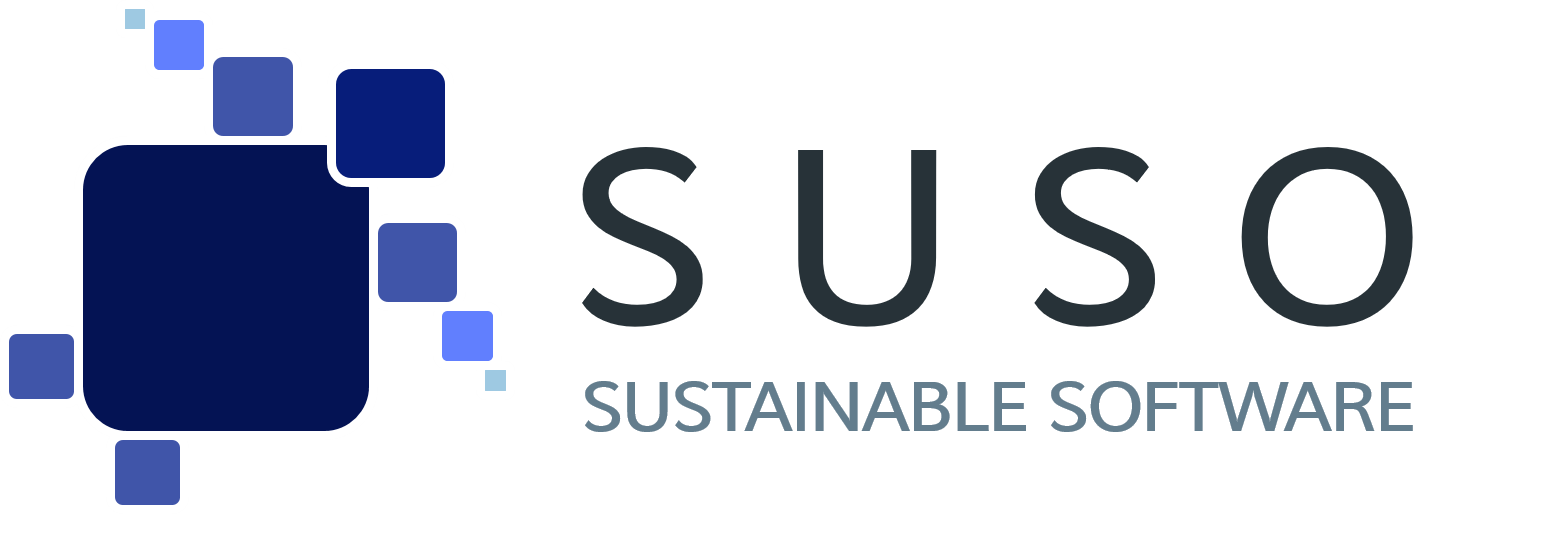Sustainability Awareness Framework (SusAF)
The Sustainability Awareness Framework (SusAF) is a tool for sustainable design of software products and services. The SusAF workbook enables you to perform a guided capture analysis of the sustainability of your software. Make yourself some coffee or tea and read through it before you start. You will understand it when your cup is empty. Cheers!
Use our whiteboard of the Sustainability Awareness Framework (SusAF)
As you can see on pages 19 to 25, the goal of the Sustainability Awareness Framework (SusAF) is to complete the Sustanability Awareness Diagram (SusAD). To do this, use our whiteboard template, which you can also find in the PDF above on pages 24 and 25.
This tool here (Ziteboard) works quite simply. First, click on “Open” in the upper right corner. Select the arrow cross to navigate through the whiteboard with the mouse. Select the postit icon and click on “Add a Sticky.” Now you can write something and change the size and color of the postit. To move it, click again on the arrow cross and then with the left mouse button on the desired postit. After two or three minutes you will get used to it!
Don’t forget to save your result as a PDF! It will not be saved on this website.
Recommendation: Involve stakeholders in the work with the Sustainability Awareness Framework (SusAF)!
Stakeholders are persons or groups that are affected by or can influence a decision or a project. In the context of software development, stakeholders can be customers, users, employees, managers, suppliers, or other involved parties. Each stakeholder has different needs, goals, and expectations for the software project. This must be considered to ensure that the software is useful and effective for all stakeholders.
It is important to involve stakeholders in the design of software in a participatory manner, rather than working on it alone. As this can help ensure that the final product is better aligned with stakeholder needs and expectations. When stakeholders are involved in the development process, they can use their knowledge and experience to improve the design, uncover potential problems, and ensure that the final product meets requirements. This can help save time and resources by identifying and fixing problems early, before the product is released.
Participatory stakeholder engagement can also help increase software adoption. Stakeholders feel that their needs and expectations have been considered. This can help the product be more successful and increase customer and user satisfaction. Overall, participatory stakeholder involvement in the development process can help ensure that the software is more sustainable and better aligned with the needs of all stakeholders.
A summary of the Sustainability Awareness Framework (SusAF)

Software systems are an essential part of our modern society, and software engineering is a critical driver of social and economic activity. While software engineering typically focuses on technical elements such as artificial systems with clear boundaries and identifiable parts, software systems are embedded in other technical systems and socio-economic and natural systems. However, this embedding is not always explicit, and the effects of software systems on the natural and social environment can be far-reaching and challenging to identify.
For example, communication, travel booking, and procurement systems influence the socio-economic and natural environment in profound ways, affecting how we form relationships, how we travel, and what we buy. Unfortunately, the software engineering process rarely makes these effects explicit, making it difficult to assess a software system’s long-term and cumulative impacts on sustainability.
Designing software for sustainability is a significant challenge that can profoundly change the role of software engineering in society. As software engineers, we have a responsibility to consider the long-term consequences of our software, irrespective of the primary purpose of the system we are designing. Requirements are a critical leverage point for practitioners who want to develop sustainable software-intensive systems.
Therefore, it is essential to establish sustainability as a major concern in software engineering. We must consider sustainability explicitly in our software design process to create more sustainable software systems. This approach requires changes in the software engineering process, especially in the requirements activities.
Sustainability is the ability of a system to endure and maintain its function despite changing circumstances. While sustainability is often associated with environmental issues, it also involves considering environmental resources, societal and individual well-being, economic prosperity, and the long-term viability of technical infrastructure.
When it comes to sustainability in technical systems, software engineers tend to focus on the technical dimension, which simply measures the software system’s longevity. However, to understand broader sustainability issues, we must consider which system to sustain, for whom, over which time frame, and at what cost. This involves five interrelated dimensions.
As a software company or practitioner, it’s important to consider the long-term impacts of our systems, not just their immediate effects. There are three types of effects to consider.
The five dimensions of sustainability
- The social dimension: This dimension covers relationships between individuals and groups, such as mutual trust and communication in a social system and the balance between conflicting interests.
- The individual dimension: This dimension covers individual freedom and agency, human dignity, and fulfillment, including individuals’ ability to thrive, exercise their rights, and develop freely.
- The environmental dimension: This dimension covers the use and stewardship of natural resources, including questions ranging from immediate waste production and energy consumption to the balance of local ecosystems and climate change concerns.
- The economic dimension: This dimension covers financial aspects and business value, including capital growth and liquidity, investment questions, and financial operations.
- The technical dimension: This dimension covers the ability to maintain and evolve artificial systems (such as software) over time, including maintenance and evolution, resilience, and the ease of system transitions.
The three types of effects of sustainability
- First, immediate effects are the direct impact of creating, using, and disposing of a software system, including its features and environmental impact throughout its life cycle. An example of this is a life-cycle assessment (LCA), which evaluates the environmental impact of a product from its extraction to disposal or recycling.
- Second, enabling effects occur over time as the software system is used, and can lead to changes in resource consumption, social norms, policies, and laws.
- Third, structural effects are persistent changes observable at the macro level, which arise from the entirety of actions at the micro level. Ongoing use of a new software system can lead to changes in capital accumulation, social norms, policies, and laws, and can alter our relationship with the natural world.
Becker, C., Betz, S., Chitchyan, R., Duboc, L., Easterbrook, S. M., Penzenstadler, B., Seyff, N., and Venters, C. C. (2016). “Requirements: The Key to Sustainability,” IEEE Software (33) 2016, pp. 1–1.

Credit goes out to the researchers of the Karlskrona Manifesto for Sustainability Design (the creators of this tool).
The group behind the Karlskrona Manifesto for Sustainability Design consists of software practitioners and researchers who develop software systems that impact the world. They are increasingly aware of the responsibilities that come with their role, especially at a time when information and communication technologies are shaping the future. The signers of the Manifesto believe that sustainability is a systemic concept that must be understood in multiple dimensions, including social, individual, environmental, economic, and technical. In addition, they argue that the current state of the world is unsustainable in many ways and that technology plays a central role in both the problem and the solution. In the role of software technology designers, they believe that they are responsible for the long-term consequences of their designs and that sustainability should be considered in software development to effect positive change and prevent non-induced negative effects.

